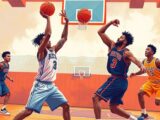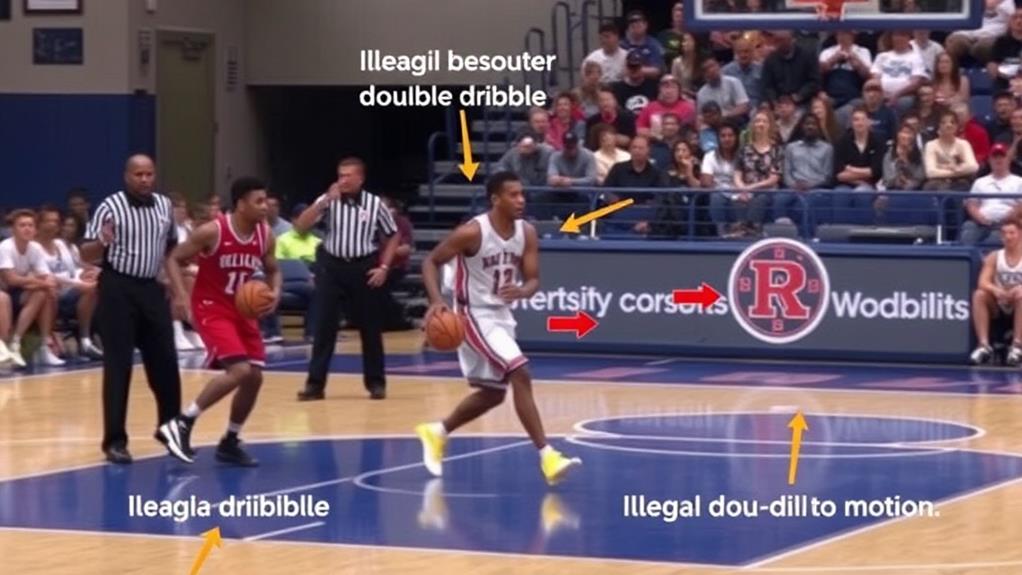
What Is a Double Dribble? Breaking Down the Rules
November 9, 2024A double dribble occurs when you dribble the ball, stop, and then start dribbling again. This violation leads to an automatic turnover, giving possession to the opposing team. It's important to remember that after you stop dribbling, you must pass or shoot before you can dribble again. Double dribbles can disrupt your team's momentum and cause confusion during gameplay. By understanding this rule, you can improve your decision-making and reduce mistakes on the court. Want to sharpen your skills further? There are many techniques and tips that can help you avoid this common pitfall.
Definition of Double Dribble
A double dribble is a violation that happens when you dribble the ball, stop, and then start dribbling again. This rule is clear under both NCAA and FIBA guidelines: once you stop dribbling, you can't begin again until a legal action occurs, like passing or shooting.
In sports like soccer, maintaining control and adhering to the rules is equally vital, as seen with the importance of team composition and player conduct. If you pick up the ball to think through your next move or lose control and then regain possession without dribbling, you're at risk of committing a double dribble violation.
As a player in control, it's important to maintain your dribbling rhythm and avoid situations that might lead to this violation. Remember, if you touch the ball again with your dribbling hand after stopping, that counts as a double dribble.
The consequences of this mistake are significant; it results in a turnover, granting possession of the ball to the opposing team. To stay competitive, you need to be aware of your actions on the court, ensuring you keep your dribble going until you decide to pass or shoot.
Understanding this definition is essential for improving your game and avoiding frustrating errors.
Reasons for Its Legality
When you think about double dribble rules, fairness in gameplay stands out as a key reason for its legality.
It keeps the game fast-paced and allows defenders to maintain pressure, enhancing their opportunities to challenge offensive plays.
Additionally, understanding the rules can create a strategic advantage for teams, enabling them to exploit scoring opportunities effectively smart defensive tactics.
Fairness in Gameplay
Fairness in basketball hinges on rules like the double dribble prohibition, which prevents players from gaining an unfair edge. This rule guarantees that offensive players can't simply regain control of the ball and start dribbling again after stopping. By enforcing the double dribble rule, defenders have a better chance to guard offensive players effectively, promoting fairness in gameplay.
Without this regulation, you'd likely see a less competitive atmosphere, as players would exploit the ability to double dribble, creating confusion and imbalances.
Moreover, the prohibition fosters skill development and strategic gameplay. You'll need to learn how to make quick decisions after your first dribble ends, which sharpens your overall basketball IQ. This dynamic encourages both players and spectators to stay engaged, as the flow of the game remains fast-paced and exciting.
Consistency in applying the double dribble rule across all levels—from youth leagues to professional play—helps everyone develop a clear understanding of the game's fundamental mechanics. It levels the playing field, guaranteeing that skill and strategy, rather than loopholes, dictate the outcome of the game.
Enhancing Defensive Opportunities
The double dribble rule not only maintains fairness but also substantially enhances defensive opportunities on the court. By prohibiting double dribbles, the game guarantees that offensive players can't regain momentum easily, which helps defenders execute their strategies effectively.
When you defend against a ball handler, knowing they can't start dribbling again after stopping gives you a tactical advantage. You can apply pressure without fearing that they'll reset and create multiple scoring options.
This rule pushes you to stay alert and responsive, allowing you to anticipate plays better. With the ball in control and the dribbler limited, you can focus on positioning and timing to disrupt their movements.
Consistency in enforcing the double dribble rule across all levels fosters a standard that enhances defensive play quality, making it easier for you to hone your skills.
As you develop your defensive strategies, understanding the implications of double dribbles empowers you. You'll find that maintaining control of a live ball and recognizing when an opponent is about to make a mistake can turn the tide in your favor, leading to more successful defensive outcomes.
Maintaining Game Flow
Flow is crucial in basketball, and the double dribble rule plays an important role in maintaining it. This rule prevents double dribbling, which can disrupt the game's rhythm and lead to unnecessary pauses. By enforcing this rule, you help create a fast-paced environment that benefits everyone on the court.
Here's why the legality of the double dribble rule matters:
- Fair Play: It guarantees offensive players can't gain an unfair advantage by changing their options after stopping their dribble, keeping the game fair.
- Engagement: It allows defenders to engage effectively, preventing prolonged offensive maneuvers that could stall the game.
- Uniformity: Consistency in applying the double dribble rule across various levels helps players adapt their skills, fostering a common understanding of game dynamics.
Understanding and adhering to the double dribble rule not only enhances the overall flow of the game but also promotes teamwork and strategic play.
Penalties for Double Dribble
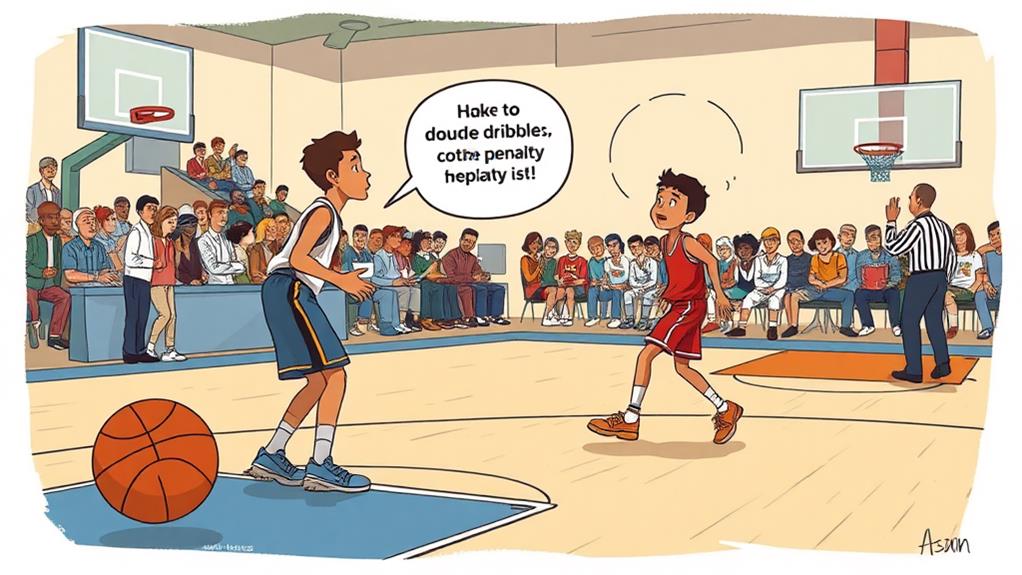
A double dribble violation leads to an immediate turnover, giving the opposing team possession of the ball. This penalty is vital in maintaining the integrity of basketball rules, much like how relegation dynamics in soccer guarantee competitive balance. When a player commits a double dribble, the game stops, and the officials enforce the penalty by awarding the ball to the opposing team.
Relegation impacts club finances greatly, highlighting the importance of adhering to rules in any sport.
In high school and college basketball, the ball is thrown in from the nearest spot to where the violation occurred. This helps keep the game flowing smoothly. Conversely, in the NBA, the ball is inbounded at a location between the free throw line and the baseline, but it can't be closer than the free throw line extended.
Enforcing double dribble penalties is essential for guaranteeing a level playing field. Consistent application of these rules prevents unfair advantages and maintains the game's integrity. Missed calls or inconsistent enforcement can greatly impact the outcome, leading to frustration for players and fans alike.
Common Game Scenarios
When you're on the court, it's easy to make common mistakes that can lead to a double dribble violation.
To enhance your ball control, focus on effective footwork drills and maintain possession with minimal touches during dribbling.
You'll want to avoid situations where you lose control of the ball or change your pivot foot unexpectedly.
Keep these tips in mind to improve your dribbling and maintain better control during the game.
Common Mistakes Made
Understanding common mistakes in basketball can considerably enhance your game. Many players, especially young players, often find themselves committing double dribbles without realizing it.
Here are three typical scenarios that lead to this violation:
- Losing Control: When you dribble in tight spaces and lose control of the ball, trying to regain it without dribbling first is a common error that results in a double dribble.
- Changing the Pivot Foot: If you change your pivot foot while holding the ball, it can mistakenly lead to a traveling violation, which is often confused with a double dribble.
- Pausing to Think: As a basketball player, if you stop dribbling to think about your next move and then touch the ball again to resume dribbling, you've committed a double dribble.
Situations to Avoid
Steering through high-pressure situations during a basketball game can easily lead to double dribble violations if you're not careful. One common scenario to avoid is regaining control of the ball after losing it without dribbling again. If you touch the ball while dribbling and then stop, starting to dribble again counts as a double.
Keep in mind that changing your pivot foot while holding the ball can lead to a traveling violation, which often gets confused with double dribbling.
Another situation to watch out for is executing fakes or hesitations. These moves might cause you to hold the ball momentarily, breaking your dribble and setting you up for a double dribble if you start dribbling again.
Additionally, dribbling in tight spaces is risky; you might lose control of the ball while dribbling, making it essential to stay aware of your surroundings.
In crowded scenarios, always be conscious of where you're moving and how you handle the ball. A small misstep can result in a double dribble violation, leading to lost possessions and missed opportunities for your team.
Stay sharp to keep the game flowing smoothly.
Tips for Players
Players often find themselves in situations where the risk of double dribbling increases, especially during fast-paced plays.
To help you avoid this violation, here are some tips:
- Stay in Control: When you dribble for a second and feel like you might lose control, regain your composure before making any moves. If you touch the ball and lose control, don't try to dribble again immediately.
- Plan Your Moves: Always have a clear plan for your next move. If you need to stop and think while holding the ball, make certain you're ready to pass or shoot rather than resuming dribbling.
- Practice Awareness: Work on drills that focus on dribbling in tight spaces. This will help you maintain control and awareness, reducing the chances of a double dribble if you find yourself in a crowded area.
Teaching Avoidance Techniques
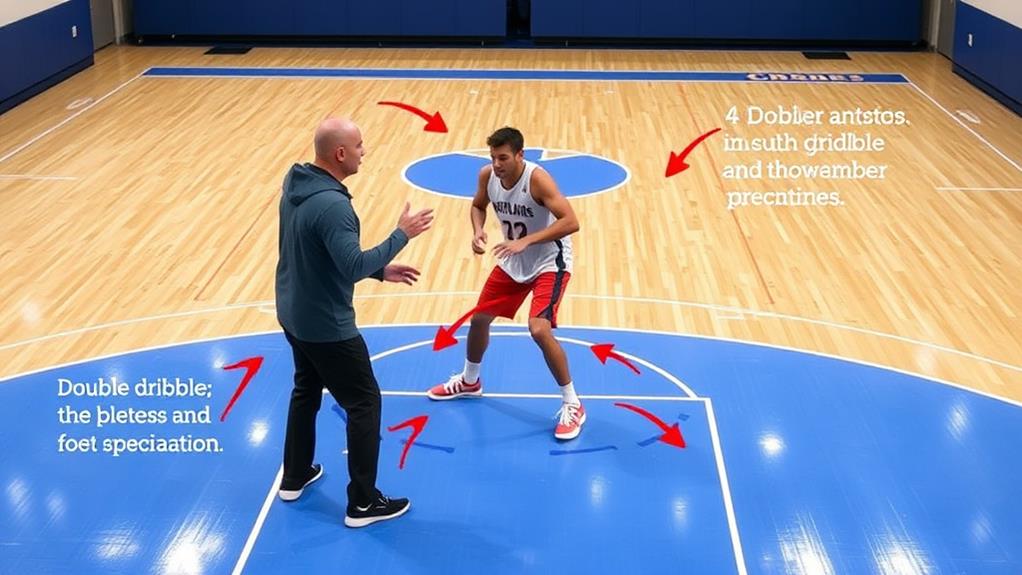
To effectively avoid double dribble violations, it's vital to instill a clear plan in young athletes' minds before they start dribbling. Encourage young players to always think ahead about their next move and to understand the importance of developing technical skills for maintaining control.
When dribbling, they should practice using both hands to enhance control, making it easier to maintain possession without the ball. This helps prevent situations where the ball comes to rest, leading to potential violations.
Incorporate drills that emphasize quick decision-making, like small-sided games, to teach them when to pass or shoot instead of dribbling again. Keeping their heads up while dribbling is essential; it allows players to be aware of their surroundings and recognize opportunities.
This awareness can prevent double dribbles, as they won't hesitate when they see an open teammate or a clear path to the basket.
Celebrate instances of good decision-making during practice using positive reinforcement, fostering confidence and skill development. Remind them that every time they lose control and dribble, they've lost, but they can learn and improve.
With these techniques, young players can navigate the court effectively without falling into the trap of double dribbles.
Enforcement Challenges
Enforcing double dribble rules presents a unique set of challenges for referees, especially in the fast-paced environment of basketball. The speed of the game often leads to missed calls, particularly during critical moments.
Here are three key enforcement challenges referees face:
1. Quick Decision-Making: Players often make rapid movements, and distinguishing between a legal play and a double dribble can be tricky when they're moving without control of the ball.
Additionally, advancements in game regulations, such as the standardization of player roles, further complicate the referee's ability to make split-second decisions.
2. Subjectivity in Calls: The interpretation of what constitutes a double dribble can vary among officials, creating inconsistencies that affect game outcomes.
This subjectivity is heightened by the ongoing rule changes in basketball, which aim to maintain fairness while also increasing the pace of play.
3. Communication Gaps: Coaches and referees need to guarantee players understand the consequences of double dribble violations, especially when the ball has been touched or been touched again after a dribble.
While double dribble violations are generally easier to enforce than other infractions like traveling, the rapid flow of the game complicates the enforcement process.
Referees must remain vigilant and responsive, as even slight lapses in attention can lead to significant discrepancies in officiating.
Impact on Game Flow
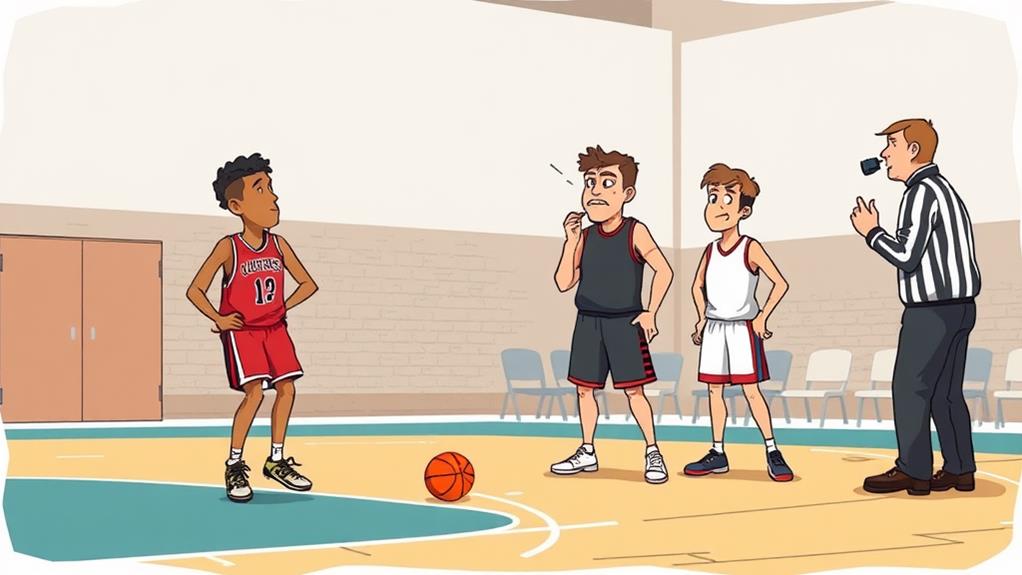
Referees' split-second decisions on double dribble violations can considerably affect the game's flow. When you commit a double dribble, it results in a turnover, halting your team's momentum and disrupting offensive continuity.
This pause not only gives the opposing team an unexpected advantage but also allows them to regroup and strategize, potentially shifting the game dynamics in their favor. The significance of maintaining consistent standards in rule enforcement, much like the relegation system in soccer, guarantees a fair competition and enhances the overall experience for players and fans alike.
The consistency of double dribble enforcement is essential for maintaining the integrity of the game. When all players adhere to the same standards, it prevents any exploitation of the rules and keeps the competition fair.
If you're aware of the double dribble rule, it can enhance your team's ability to maintain offensive continuity. By avoiding unnecessary stoppages in play, you can keep the rhythm and pace intact, allowing for a more fluid game experience.
In essence, understanding the impact of a double dribble on game flow can make a significant difference in your strategy. By minimizing turnovers and focusing on maintaining your offensive flow, you can improve your team's chances of success on the court.
Importance for Young Players
Many young players mightn't realize how vital understanding the double dribble rule is to their overall development in basketball. Mastering this rule not only enhances your skills but also promotes fair gameplay on the playing court.
Here are a few reasons why it's essential:
- Better Decision-Making: Understanding when your first dribble has ended helps you decide quickly whether to dribble or pass, improving your game IQ. Developing fundamental skills is key to making these quick decisions during a game.
- Reduced Turnovers: Knowing the double dribble violation fosters a sense of responsibility, making you more aware of your actions and less likely to mishandle the ball.
- Discipline and Confidence: Practicing how to avoid double dribbles instills discipline, allowing you to maintain control when you touch the ball and boosting your confidence during games.
As you grow and improve, keep the double dribble rule at the forefront of your training. It's a fundamental concept that not only enhances your skills but also guarantees you contribute positively to your team on the field.
Embrace the learning process, and watch your game evolve!
Related Dribbling Violations
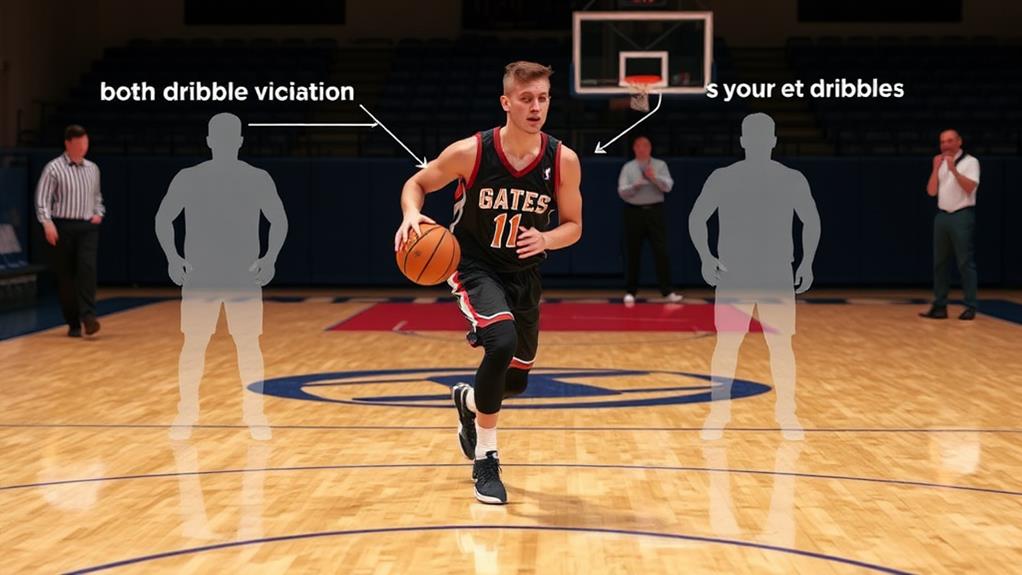
Understanding the double dribble rule naturally leads to recognizing other related dribbling violations that can impact your game. Besides double dribbling, traveling is a common mistake players often make. It happens when you take too many steps without dribbling or change your pivot foot while holding the ball. If you're not careful, you could easily lose possession.
Proper form and technique are essential in basketball, similar to executing a slide tackle, as both require precision and awareness to avoid fouls and maintain control of the game.
Another violation to be aware of is carrying. This occurs when you dribble the ball with your palm facing up, which disrupts the game's flow and could result in a turnover. Both traveling and carrying are illegal and can cost you valuable points if not managed properly.
You should also know that you can legally resume dribbling after a field goal attempt or if the ball is touched by an opponent. Additionally, if you fumble the ball that has touched another player, you're allowed to continue dribbling.
Being aware of these nuances helps you maintain possession and avoid costly mistakes during gameplay. By mastering these related violations, you'll enhance your skills and improve your overall performance on the court.
Conclusion
In summary, understanding double dribble rules is essential for players at all levels. It keeps the game fair and fluid. For instance, imagine a young player, Alex, who gets called for a double dribble during a significant moment in a game. Instead of feeling defeated, they learn from it, practice more, and avoid the mistake in future games. Embracing these lessons not only improves skills but also enhances the overall enjoyment of basketball.

